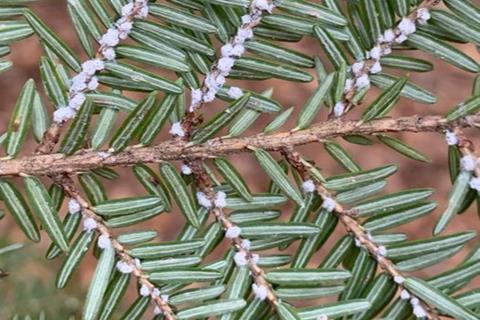A non-native, hemlock-loving invasive insect species known as the hemlock woolly adelgid is wiping out stands of Eastern hemlock throughout the East Coast of the U.S. Though no trees survive completely, some stands are able to resist the invasion for longer than others, and the Department of Energy recently awarded $999,990 to a team of scientists, led by Ashley Keiser, assistant professor in the Stockbridge School of Agriculture at the University of Massachusetts Amherst, to find out why.

The hemlock woolly adelgid first arrived in the U.S. in the early 1950s, and, as the climate has warmed, it has spread from its initial berth in Virginia to 19 different states, from Georgia to Maine and west to Michigan. The insect feasts on the sap of Eastern hemlock, slowly starving the tree. Many of the infected hemlocks will die slowly over the course of a decade — but not all of them.
READ MORE: Under the microscope: the rhizosphere
READ MORE: Scientists graft Prunus sp. to control crown gall disease by regulating the rhizosphere environment
“There’s been an unequal decline,” says Keiser. “In fact, at the Harvard Forest in central Massachusetts, there are two different, non-contiguous stands of hemlock, each infected with hemlock woolly adelgid at the same time. One stand is suffering badly, but the other seems to be managing the infection.”
Long term experiments
The Harvard Forest is one of the U.S. National Science Foundation’s Long Term Ecological Research (LTER) sites, which host decades-long ecological experiments, and will be one of the places Keiser and her team focus on over the next three years, along with Hubbard Brook in New Hampshire, another LTER site.
It could simply be that the soil in one place is more conducive to hemlock health than in the other, but Keiser and her colleagues, including co-investigator Kristen DeAngelis, professor of microbiology at UMass Amherst, suspect something much more complex: the feedback loop involving the adelgid, the hemlock, soil microbes, and the carbon and nitrogen stocks in the soil.
The adelgid feasts on hemlock sap because it’s rich in carbon and nutrients, which the tree uses for its own benefit. But hemlocks, like all trees, also feed soil microbes by actively exuding compounds beneficial to the below-ground microbial community. These ‘exudates’ include carbon, and up to 50% of the carbon that a tree takes into its system might be shared below ground as low molecular-weight carbon compounds within the “rhizosphere,” or the soil and microbes that cluster around each tree’s roots.
Repaying the trees
In fact, the rhizosphere microorganisms get up to 50% of their energy from the plants growing in their midst, but whereas the adelgid eventually kills its host, the microbial community actively repays hemlocks by helping to ensure their health.
“We know that plants can shift the composition of their exudates when they’re under stress, including when chewed on through herbivory,” says Keiser. “But we don’t know what changes in exudation from a non-native pest, like the hemlock woolly adelgid, does to the rhizosphere or how it affects stocks of carbon and nitrogen in the soil. We also don’t know why plants are shifting their exudation — is it because the adelgid is draining its resources or is it a deliberate response?”
Keiser and her team’s research branches out even further than the relationship between insects, trees and microbes to the carbon cycle of entire forests and, therefore, to the Earth’s climate. Working with colleagues Debjani Sihi at North Carolina State University and Benjamin Sulman at Oak Ridge National Laboratory, the team will translate their local results into ecosystem models in order to predict forest-level changes in carbon and nitrogen cycling. Since trees and microbes are one of the conduits through which carbon passes from the atmosphere to the soil, and vice versa, anything, like the adelgid, that affects this relationship stands to alter the world’s carbon balances—but again, no one knows exactly how.
“We’re going to be able to incorporate our findings into ecosystem models so that we can better understand what happens to forest carbon cycling as we lose Eastern hemlocks,” says Keiser.







No comments yet